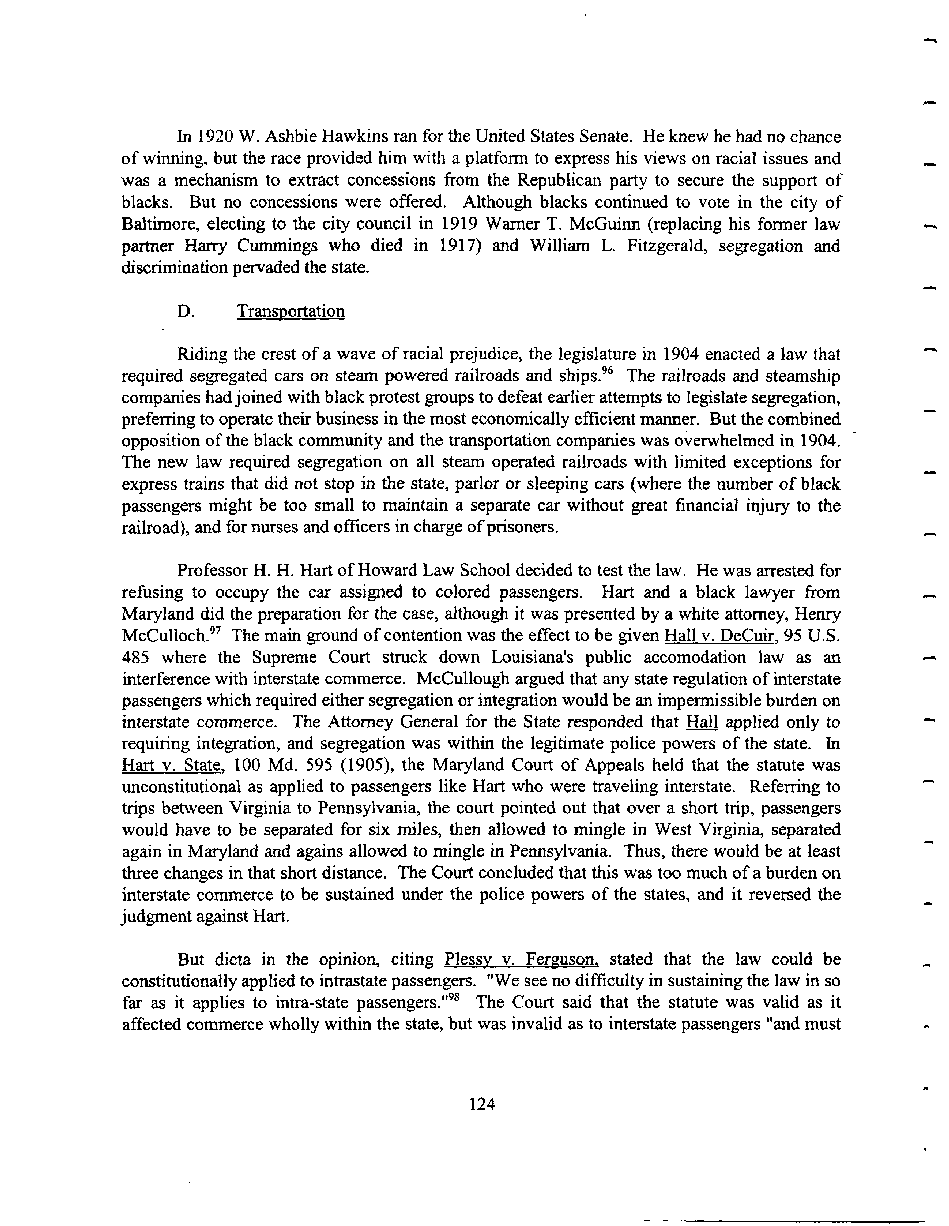|
In 1920 W. Ashbie Hawkins ran for the United States Senate. He knew he had no chance
of winning, but the race provided him with a platform to express his views on racial issues and
was a mechanism to extract concessions from the Republican party to secure the support of
blacks. But no concessions were offered. Although blacks continued to vote in the city of
Baltimore, electing to the city council in 1919 Warner T. McGuinn (replacing his former law
partner Harry Cummings who died in 1917) and William L. Fitzgerald, segregation and
discrimination pervaded the state.
D. Transportation
Riding the crest of a wave of racial prejudice, the legislature in 1904 enacted a law that
required segregated cars on steam powered railroads and ships.96 The railroads and steamship
companies had joined with black protest groups to defeat earlier attempts to legislate segregation,
preferring to operate their business in the most economically efficient manner. But the combined
opposition of the black community and the transportation companies was overwhelmed in 1904.
The new law required segregation on all steam operated railroads with limited exceptions for
express trains that did not stop in the state, parlor or sleeping cars (where the number of black
passengers might be too small to maintain a separate car without great financial injury to the
railroad), and for nurses and officers in charge of prisoners.
Professor H. H. Hart of Howard Law School decided to test the law. He was arrested for
refusing to occupy the car assigned to colored passengers. Hart and a black lawyer from
Maryland did the preparation for the case, although it was presented by a white attorney, Henry
McCulloch.97 The main ground of contention was the effect to be given Hall v. DeCuir, 95 U.S.
485 where the Supreme Court struck down Louisiana's public accomodation law as an
interference with interstate commerce. McCullough argued that any state regulation of interstate
passengers which required either segregation or integration would be an impermissible burden on
interstate commerce. The Attorney General for the State responded that Hall applied only to
requiring integration, and segregation was within the legitimate police powers of the state. In
Hart v. State. 100 Md. 595 (1905), the Maryland Court of Appeals held that the statute was
unconstitutional as applied to passengers like Hart who were traveling interstate. Referring to
trips between Virginia to Pennsylvania, the court pointed out that over a short trip, passengers
would have to be separated for six miles, then allowed to mingle in West Virginia, separated
again in Maryland and agains allowed to mingle in Pennsylvania. Thus, there would be at least
three changes in that short distance. The Court concluded that this was too much of a burden on
interstate commerce to be sustained under the police powers of the states, and it reversed the
judgment against Hart.
But dicta in the opinion, citing Plessy v. Ferguson. stated that the law could be
constitutionally applied to intrastate passengers. "We see no difficulty in sustaining the law in so
far as it applies to intra-state passengers."98 The Court said that the statute was valid as it
affected commerce wholly within the state, but was invalid as to interstate passengers "and must
124
�
|

